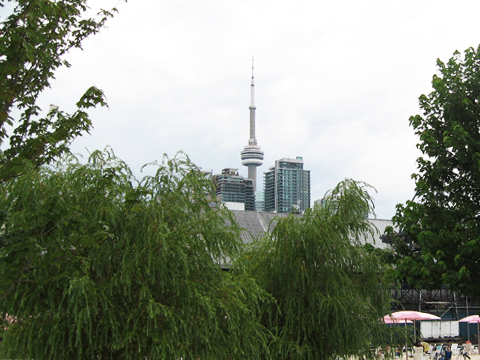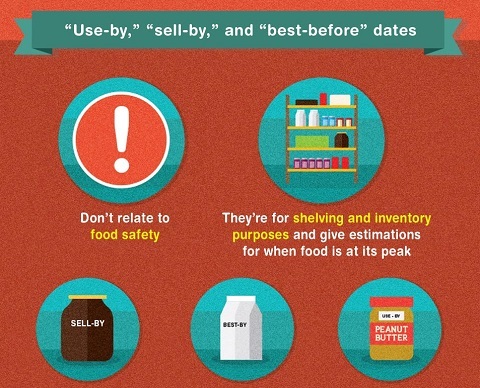David Suzuki's Blog, page 50
November 23, 2015
Biking and walking in the city

(Credit: eric robinson via Flickr)
Most Ontarians live in cities and one of the ways to support good physical, mental and social health is to build healthy cities. How cities are organized affects individuals' ability to be active physically, economically, or socially. Making active transportation the safe and easy choice can also affect air quality and contribute to lowering the burden of illness associated with airborne pollution.
Increasing opportunities to be active in the city is important in building social connections and is essential to the continued growth of Toronto. Physical activity reduces the risk of over 25 chronic diseases including coronary heart disease, hypertension, breast cancer, colon cancer, Type 2 diabetes and osteoporosis. However, high-density traffic, air pollution and lack of cycling and pedestrian infrastructure make it difficult for people to stay active.
Torontonians have already benefited from more stringent emission and fuel economy standards. In 2007, air pollution from traffic was responsible for 440 premature deaths and 1,700 hospitalizations in Toronto. By 2014 these figures had each fallen by 36 per cent. These health benefits can be enhanced by investing in walkable and bikeable communities that allow more drivers to switch to active transportation.
Providing safe infrastructure for active transportation is a critical step in increasing physical activity and potentially improving air quality. Barriers to biking vary by community but some common ones are disconnected bike lanes and high-density traffic. A total of 55 per cent of trips taken within the city of Toronto are less than seven kilometres long. A safe, well-connected network of bike lanes and trails could go a long way to help increase the number of cyclists in our city.
Working towards meeting our larger environmental goals while simultaneously tackling the problem of inactivity benefits everyone. This can be supported by developing complete streets guidelines and implementing active city principles, to name but a few options.
Healthy cities that support everyone's health don't just happen. A high degree of engagement and participation is required to grow the kind of city we want to live in.
We all have a part to play in making biking and other active transportation options like walking, taking transit and rolling more accessible to everyone in cities across the country. Help create a positive reception for city-wide complete street guidelines and help make them a reality by talking about how you think they will make the city a better place. You can also share your opinions by attending public consultations and expressing why you think active living infrastructure (including biking) is important.
Above all else, the best way to support new infrastructure and decrease inactivity is for you to start biking and keep biking. It's worth it.
Hey! Want more DSF? Join David Suzuki on Facebook
November 22, 2015
Alberta launches next phase of Canadian climate action, demonstrating strong provincial leadership
VANCOUVER -- Alberta's comprehensive strategy to phase out coal power, ramp up renewable energy, put a price on carbon pollution and limit emissions from oilsands demonstrates that provinces can take strong, determined leadership on climate change, even those with economies traditionally linked to fossil fuel development.
The strategy, which includes a phase-out of coal-fired power by 2030, a ramp-up of renewable energy to 30 per cent by 2030, a 100 megatonne limit on oilsands emissions and a $30 per tonne price on all carbon emissions by 2018, marks a profound shift in the province's approach to climate action, according to the David Suzuki Foundation.
"It's another example of the way Canadian provinces and cities are leading the way on climate change while strengthening and diversifying their economies," said David Suzuki Foundation science and policy manager Ian Bruce.
Revenues from the carbon-pricing plan would be earmarked for clean technology and innovation, public transit, clean energy infrastructure, a First Nations fund and support for low-income households. "Alberta's comprehensive energy strategy marks a new era of Canadian leadership on climate change," said Bruce. "The shift toward a clean-energy economy is already happening, with cities and provinces leading the way. The last piece of the puzzle will be a strategy from the federal government to build on the growing momentum."
"Although there's still room for improvement, the commitments we've seen are important contributions to solving the climate crisis and set the stage for progressively stronger targets as we aim for a renewable energy economy by 2050," Bruce said. "Coal power in Alberta puts nearly as much carbon into the air as all oilsands operations, so the impact of phasing out these massively polluting power plants and shifting to zero-emission power sources is a landmark step that will cut emissions and save lives."
Saskatchewan, meanwhile, has committed to 50 per cent renewable energy capacity by 2030 and Ontario released details of its forthcoming cap-and-trade regime. With the United Nations climate summit in Paris only a week away, the message from leaders across the country is clear: It's time to accelerate Canada's shift to a clean-energy economy.
Federal leaders heading to Paris will no doubt make note of the strong call to action from provinces and Canadians. Recent polling by the Environics Institute for Survey Research shows that a growing majority of Canadians want the federal government to sign on to a strong international agreement to cut carbon emissions.
"Collective will is what moves the needle on major issues like climate change," said David Suzuki Foundation CEO Peter Robinson. "Canada has a historic opportunity to show global leadership in Paris, by adopting the strongest policies already in place in parts of the country and developing a unifying climate change strategy that would allow us to meet our international commitments and targets."
For information, please contact:
Alvin Singh, Communications Manager
David Suzuki Foundation
604-250-2651
asingh@davidsuzuki.org
Hey! Want more DSF? Join David Suzuki on Facebook
Alberta launches next phase of Canadian climate action demonstrating strong provincial leadership
VANCOUVER -- Alberta's comprehensive strategy to phase out coal power, ramp up renewable energy, put a price on carbon pollution and limit emissions from oil sands demonstrates that provinces can take strong, determined leadership on climate change, even those with economies traditionally linked to fossil fuel development.
The strategy, which includes a phase out of coal-fired power by 2030, a ramp up of renewable energy up to 30 per cent by 2030, a 100 megatonne limit on oilsands emissions and a $30 per tonne price on all carbon emissions by 2018, marks a profound shift in the province's approach to climate action, according to the David Suzuki Foundation.
"It's another example of the way Canadian provinces and cities are leading the way on climate change while strengthening and diversifying their economies," said David Suzuki Foundation science and policy manager Ian Bruce.
Revenues from the carbon pricing plan would be earmarked for clean technology and innovation, public transit, clean energy infrastructure, a first nations fund and support for low income households. "Alberta's comprehensive energy strategy marks a new era of Canadian leadership on climate change," said Bruce. "The shift toward a clean-energy economy is already happening, with cities and provinces leading the way. The last piece of the puzzle will be a strategy from the federal government to build on the growing momentum."
"Although there's still room for improvement, the commitments we've seen are important contributions to solving the climate crisis and sets the stage for progressively stronger targets as we aim for a renewable energy economy by 2050," Bruce said. "Coal power in Alberta puts nearly as much carbon into the air as all oilsands operations, so the impact of phasing out these massively polluting power plants and shifting to zero-emission power sources is a landmark step that will cut emissions and save lives."
Saskatchewan, meanwhile, has committed to 50 per cent renewable energy capacity by 2030 and Ontario released details of its forthcoming cap-and-trade regime. With the United Nations climate summit in Paris only a week away, the message from leaders across the country is clear: It's time to accelerate Canada's shift to a clean-energy economy.
Federal leaders heading to Paris will no doubt make note of the strong call to action from provinces and Canadians. Recent polling by the Environics Institute for Survey Research shows that a growing majority of Canadians want the federal government to sign on to a strong international agreement to cut carbon emissions.
"Collective will is what moves the needle on major issues like climate change," said David Suzuki Foundation CEO Peter Robinson. "Canada has a historic opportunity to show global leadership in Paris, by adopting the strongest policies already in place in parts of the country and developing a unifying climate change strategy that would allow us to meet our international commitments and targets."
For information, please contact:
Alvin Singh, Communications Manager
David Suzuki Foundation
604-250-2651
asingh@davidsuzuki.org
Hey! Want more DSF? Join David Suzuki on Facebook

November 19, 2015
Winds of change blow across the Prairies

(Credit: Anthony Quintano via Flickr)
Just three years ago, the David Suzuki Foundation produced All over the map 2012: A comparison of provincial climate change plans. The report found Saskatchewan was the largest per capita producer of greenhouse gas emissions in the country. "It is difficult to image a province taking the threats of climate change less seriously," it pointed out. Fortunately, this statement can no longer be made about the province known for its CFL football fans, Gordie Howe and strong community spirit.
On November 18, Saskatchewan Premier Brad Wall announced that his province has committed to 50 per cent renewable energy by 2030. The province will employ solar, wind and geothermal energy to reduce its reliance on coal and natural gas to produce electricity. This is a dramatic increase from the previous goal of 12 per cent wind generation by 2030. The shift will allow Saskatchewan to reduce coal-fired electricity generation and the pollution and related health impacts it creates. SaskPower plans to release details of the plan to reach 50 per cent renewable energy next week, but one thing is clear: Canada's provinces are taking the lead on climate policies in the lead-up to the Paris UN climate negotiations later this month.
British Columbia, Ontario and Quebec have been Canadian leaders in climate change policy for several years, but provinces like Saskatchewan and Alberta are now also taking concrete steps to reduce the effects of climate change. Next week, Alberta is expected to release its climate change action plan and provide details on an accelerated phase-out of coal-generated power. In advance of the most important international climate meeting since 1997, Canadians should be encouraged that our provinces are ready to enact solutions.
Momentum is building across Canada for a shift to the policies we need to succeed in resolving the climate crisis. The final piece of the puzzle will be strong leadership from the federal government to create ambitious emissions reduction targets, a price on all carbon emissions, investments in low-carbon infrastructure like transit and renewable energy and strong efficiency standards for vehicles and buildings.
Many provinces and cities are demonstrating commitments to do their fair share to address climate change. The timing couldn't be better. As impressive as our provinces' efforts have been, a concerted national effort led by the new federal government will allow Canadians to stand tall as we do our part to combat global warming.
As leaders across the country work to show support for climate action, it's important for ordinary Canadians to do the same. Events like the 100% Possible march in support of climate action in Ottawa on November 29, along with related events across Canada, are one way to get involved. You can also email your premier, local MP, or the prime minister himself to express how much climate action matters to you. When we all speak up, extraordinary leadership will follow.
YES -- I'll send a message to Canada's leaders.
Hey! Want more DSF? Join David Suzuki on Facebook

November 18, 2015
Natural infrastructure is good for the climate and communities

(Credit: DeepRoot via Flickr)
Across Canada, towns and cities face a one-two punch: aging infrastructure and the extreme weather climate change brings. Unless we do something, many of our roads, railways, transit lines, bridges, stormwater pipes and other built structures could become obsolete.
Our newly elected federal government took up the challenge with a campaign pledge to double infrastructure investments from $65 billion to nearly $125 billion over the next 10 years. Ontario has committed to spending $130 billion over the same time period, and Alberta Premier Rachel Notley has also promised a hefty infrastructure stimulus package.
While these political commitments are long overdue, we shouldn't lose sight of less-expensive and longer-lasting solutions to many of our infrastructure needs, like planting trees in urban areas for stormwater management and other services.
Many municipalities and non-profit organizations are exploring ways to improve how we plan for, plant, maintain and protect urban trees as key infrastructure assets in our built environments. But higher levels of government must also fund and participate in urban forest strategies to ensure that trees are promoted in our ever-densifying urban centres.
We often take trees and green spaces for granted, but we shouldn't. They clean and cool air, filter and regulate water, reduce energy use and protect homes and businesses during storms. Recognizing urban trees as infrastructure assets opens up new ways to assess their value and justify investment in their maintenance. Living, green infrastructure increases in value over time, unlike grey infrastructure, such as stormwater pipes, which depreciate. As trees mature they provide exponentially more benefits to residents.
Healthy street trees can lengthen the lifespan of built infrastructure like roads and sidewalks by shading them and reducing effects of weathering, and they provide significant human health benefits. This summer, using data from Toronto, David Suzuki Foundation Ontario director Faisal Moola and his academic colleagues found that adding 10 trees to a block can produce health benefits equivalent to a $10,000 salary raise or being seven years younger.
Despite their enormous value to society, urban forest canopies are stressed and in decline in many parts of the country. Hot, dry summers and increasingly frequent and extreme storms are wreaking havoc on city trees. Urban development, invasive species like the emerald ash borer and other threats have also reduced growing space and killed millions of trees.
Unfortunately, urban forest stewardship varies widely across the country. Few municipalities have the necessary financial resources to manage and protect their urban forests in the face of growing and diverse threats. Too often, municipalities scramble to handle damage caused by unpredictable storms, invasive species and urban development using a triage approach, when a proactive and comprehensive strategy is critically needed.
To help resolve this, provincial and federal governments need to update the definition of infrastructure to include green infrastructure such as trees, rain gardens and permeable surfaces, and allow municipalities to spend money to develop and maintain these assets.
Higher levels of government must also update the standards by which municipalities report and manage their government assets to include trees, parks, wetlands, woodlots and public aquifers. That would facilitate setting minimum provincial standards for maintenance of critical green infrastructure and would improve management practices. We have provincial standards for grey infrastructure such as roads, so why not for green infrastructure? With the help of the David Suzuki Foundation, the tiny town of Gibsons, B.C., has already started on this path.
It's also important to make living, green infrastructure a crucial component of provincial and federal climate change strategies. Urban forests contribute greatly to reducing greenhouse gas emissions by absorbing and storing carbon dioxide in tree biomass, understory vegetation and soils. Urban trees also help us adapt to and cope with climate change impacts by shading communities during periods of extreme heat. The unique, multi-purpose benefits of living, green infrastructure make it an incredibly valuable tool for cities and towns to improve resiliency in the face of climate change.
If we're going to build, let's build green. Green infrastructure complements and reduces costs associated with traditional grey concrete, steel and asphalt infrastructure. It also provides a multitude of co-benefits that improve the health and well-being of residents and makes our communities more beautiful and pleasant.
Hey! Want more DSF? Join David Suzuki on Facebook

November 15, 2015
DIY recipes to help combat colds and flu

Hydrogen peroxide is a great disinfectant and breaks down into oxygen and water so it's kind to the environment. (Credit:Brendon Purdy)
There is no evidence that antibacterial products actually do a better job than regular soap in a household setting. So avoid them UNLESS you work in a hospital.
Why? Overuse of antibacterial ingredients -- like triclosan -- is helping create superbugs. Our increasing obsession with avoiding germs could actually be making us sick.
What is triclosan?
Triclosan is used in cleansers, antiperspirants/deodorants, toothpastes and hand sanitizers as a preservative and anti-bacterial agent. It's toxic to fish and wildlife and may be an endocrine disrupter i.e., interfere with hormone function. It's best avoided, which can be tricky because it seems like it's in everything -- soaps, countertops, garden hoses, garbage bags, socks, laundry products, facial tissues and more.
How to shop smarter
Avoid anything labelled "anti-bacterial".
Avoid triclosan in the ingredient list.
Avoid parfum (a.k.a fragrance). Some fragrance ingredients can trigger allergies and asthma. Some are linked to cancer and neurotoxicity. Some are harmful to fish and other wildlife.
Choose bar soaps -- a U.S. study found triclosan in 76 per cent of liquid soaps and only 29 per cent of bar soaps (American Journal of Infection Control, 2002).
Choose products that list ingredients (especially home cleaners).
Choose products with plant-based ingredients. * Choose products with ECOLOGO or Green Seal labels.
If you live or work with children, non-toxic disinfectants are even more important. Kids are not miniature adults -- kilogram for kilogram they absorb more chemicals. They're closer to the ground and they have an "exploratory nature" -- they put everything in their mouths!
Germ killing DIY recipes
One way to get off the antibacterial crazy train -- make your own soap, hand sanitizer, cleaner and disinfectant!
Liquid hand or body soap (takes less than 10 minutes)
Add to soap dispenser (even the foaming kind):
¾ cup (187.5 ml) water
¼ cup (62.5 ml) liquid castile soap (unscented or scented with essential oils; available at most health food stores or organic grocers)
Check out my four-part blog on how to make your own cold-process bar soap with vegetable oils and natural exfoliants.
Hand sanitizer
¼ cup (62.5 ml) pure aloe gel
½ cup (125 ml) grain alcohol (e.g., vodka) or rubbing alcohol
5 to 8 drops tea tree or thyme essential oil
Optional: add 2 T (30 ml) vegetable glycerin to combat alcohol's drying effect
Mix and store in a squeeze bottle. Keep a batch in your diaper bag, child's backpack, at your desk or in your purse or car.
All-purpose spray cleaner
Mix equal parts white vinegar and water
Optional: add 3 to 5 drops of thyme essential oil
Add to a spray bottle. Use it to clean your home -- wipe down countertops, keyboards, doorknobs, etc.
Acetic acid (white vinegar) is a great disinfectant, deodorizer and grease cutter. It tackles salmonella (some strains), E. coli and other "gram-negative" bacteria that can cause pneumonia, meningitis and bloodstream, wound or surgical site infections.
The acid in vinegar crosses the bacteria cell membrane and prompts a release of protons that kills the cell. Heinz unveiled a "cleaning" version of its white distilled vinegar -- instead of five per cent acetic acid, it has six. Some "eco" stores sell a 12 per cent solution. Simply heating vinegar can also boost its power.
Disinfectant spray
Transfer store-bought hydrogen peroxide to a dark spray bottle (it's sensitive to light).
Unlike chlorine bleach, hydrogen peroxide breaks down into oxygen and water and is kind to the environment. Did you know eco or oxygen bleach is really diluted hydrogen peroxide?
On their own, vinegar and hydrogen peroxide are each strong germ killers. Used in combination, they're even better -- 10 times more effective than disinfecting with either substance alone and more effective than bleach in the kitchen.
Here's the catch: mixing them together cuts their germ-killing power, but using one after the other works well.
Hey! Want more DSF? Join David Suzuki on Facebook

November 13, 2015
Climate broadcast suspended in light of Paris attacks
With today's horrific events in Paris, Al Gore has announced that the Live Earth and 24 Hours of Climate Reality broadcast is being suspended. The presentation by David Suzuki Foundation Science and Policy Manager Ian Bruce will not go ahead. Our thoughts go out to the people of France in this time of tragedy.
Hey! Want more DSF? Join David Suzuki on Facebook

November 12, 2015
Tell Canada's leaders that you care about climate action in Paris

Cities and provinces have been leading the way in Canada, but it's now time for the federal government to develop a coordinated national strategy to reduce emissions and diversify our economy.
Hey! Want more DSF? Join David Suzuki on Facebook

Don't confuse "best before" with "expired"

Did you know that milk can be consumed 7 days after the "best before" date, opened or unopened? (Credit: Fix.com)
Are you sitting down?
Yogurt with a best before date of today is still good (and safe) to eat for seven to 10 days (open or unopened)!
Reading best before dates as expiry dates probably contributes to food waste and "every year a staggering one-third -- 1.3 billion tonnes -- of the world's food is wasted after it has been harvested: 45 per cent of fruit and vegetables, 35 per cent of fish and seafood, 30 per cent of cereals, 20 per cent of dairy products and 20 per cent of meat."
Let's change that.
Best before dates have to do with food quality -- freshness, texture, flavor and nutritional value -- not safety. They are not expiry dates.
I suspect not confusing "best before" with "expired" will lead to these three things:
You'll waste less food.
You'll save money.
You'll avoid sending food waste to the landfill, which contributes to increasing methane emissions and significantly adds to our climate change woes.
How long after a best before date can I safely eat eggs, milk, mustard, cereal, etc.?
LoveFoodHateWaste.ca shares storage time limits, e.g., you can consume eggs one month after the best before date.
EatbyDate.com explains how long food lasts.
Fix.com shares a pantry guide for dry goods.
What happens to food after its best before date?
After the best before date has passed, food may lose some freshness and flavour and texture may change. Some foods lose nutritional value, e.g., contain less vitamin C.
You can buy and eat foods after their best before dates have passed. (I use them to my advantage and enjoy best before sales at the grocery store!)
Where will you see best before dates?
Best before dates are only required on foods that stay fresh for 90 days or less. Some things have them that don't need them, like bottled water!
Only a few foods -- like infant formula and formulated liquid diets -- actually have expiry dates.
Note: Always avoid leaky or bulging canned goods.
What surprised you about best before dates?
Sincerely,
Lindsay Coulter, a fellow Queen of Green
Hey! Want more DSF? Join David Suzuki on Facebook

November 11, 2015
New government faces climate challenges and opportunities

(Credit: Moyan Brenn via Flickr)
Our new government appears to be taking climate change seriously. With the UN climate talks starting in Paris on November 30, Canada can play an important role in reducing greenhouse gases at home and helping others around the world do likewise. U.S. President Barack Obama's decision to reject the Keystone XL oilsands pipeline reinforces the fact that we can't continue burning fossil fuels at current rates.
Although Canada's government is heading to Paris without a strong plan, it has indicated it's ready to represent Canadians' interests. One of the first encouraging signs is the new cabinet.
In the reduced, 30-member cabinet, equally divided between women and men, the minister of environment's title has been expanded to include climate change, and we now have a minister of science and a minister of innovation, science and economic development.
I and others have been warning about global warming and its consequences for decades. I spoke to science writer Isaac Asimov about it in 1977 on CBC Radio's Quirks and Quarks. In 1989, The Nature of Things did its first global warming program and I hosted the five-part radio series, It's a Matter of Survival, in part about climate change. The David Suzuki Foundation has worked hard over its 25-year history to inform people about climate change and to research solutions, recently through the Trottier Energy Futures Project.
The UN climate conference, just weeks away, presents an immediate challenge for the government, but Canada is in an ideal position to make positive contributions. Besides the new minister of environment and climate change and the prime minister, a cabinet committee on environment, climate change and energy will attend, headed by Foreign Minister Stéphane Dion.
Recognizing the role of provincial governments and other parties in addressing climate change and reducing greenhouse gas emissions, Prime Minister Justin Trudeau has also invited provincial premiers and other party leaders, including Green Party leader Elizabeth May, to the conference.
Given the ever-increasing urgency of the climate crisis, the UN process has been frustratingly slow and lacking in the kinds of concrete actions required to keep global average temperatures from rising more than 2 C. The goal of the Paris talks is for developed and developing nations to adopt a legally binding universal climate agreement to reduce greenhouse gas emissions and provide financing for developing nations.
To help guide negotiations, the David Suzuki Foundation has offered recommendations to Canada's new government. The first is to develop a national climate action plan that sets new, ambitious emissions-reduction targets. We agree with the Climate Action Network Canada that cutting carbon emissions by one-third within a decade, or 35 per cent below 1990 levels by 2025, would fit the bill, and that reductions should begin immediately with targets enshrined in law.
The Foundation also believes the federal government must work with provinces to set a minimum standard for pricing carbon emissions, through carbon taxes, cap and trade or both, reaching at least $100 per tonne by 2020, and applying targeted regulations or standards where carbon price alone is not enough to meet emissions targets.
We'd also like to see government move ahead with commitments to low-carbon infrastructure, including investment in public transportation, renewable energy and climate adaptation, as well as employing natural systems to reduce impacts. Energy-efficiency standards for vehicles and buildings are also essential, as is a commitment to support the UN Green Climate Fund for developing nations.
We and other organizations will offer suggestions on a range of issues. For us, these include species at risk and habitat protection, marine protected areas, environmental rights, natural capital evaluation and improved relations with indigenous peoples. We realize the new government faces numerous challenges and must deal with competing interests around falling oil prices, pipeline projects, missing and murdered aboriginal women, national security, international commitments regarding terrorism and more. It won't be easy and they'll have to hit the ground running.
As leaders from Canada and the U.S. head to Paris with real commitments to address climate change, there's hope for progress. This government seems open to engaging in conversations with Canadians from all walks of life and all parts of the country, and to accepting our global responsibilities. I wish them the best.
Hey! Want more DSF? Join David Suzuki on Facebook

David Suzuki's Blog
- David Suzuki's profile
- 247 followers



